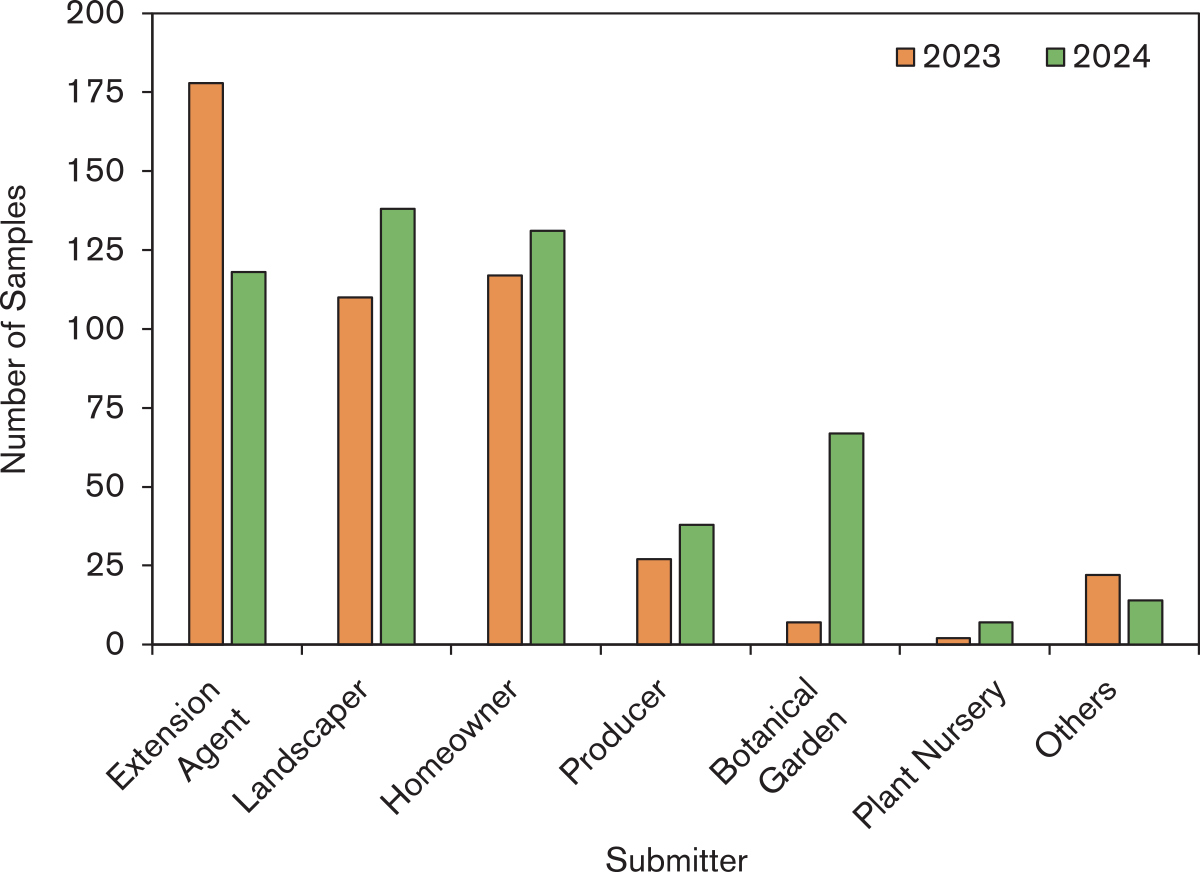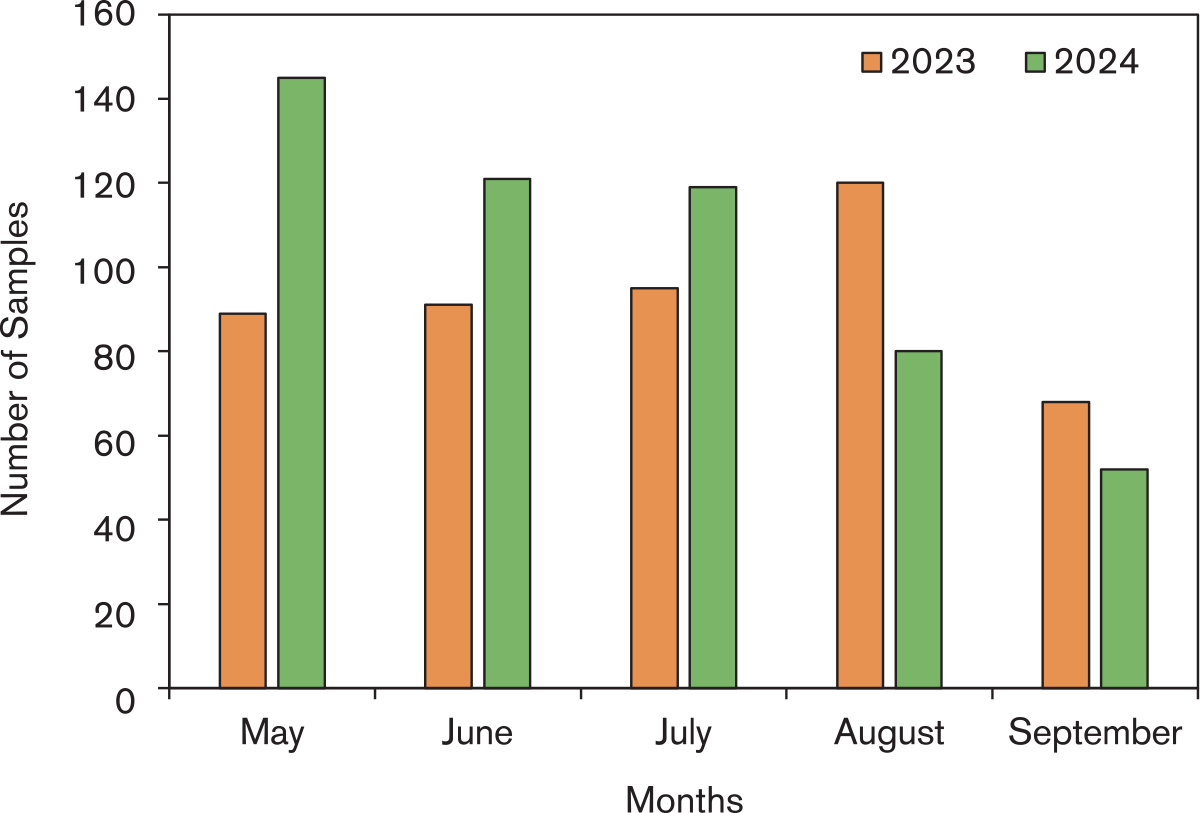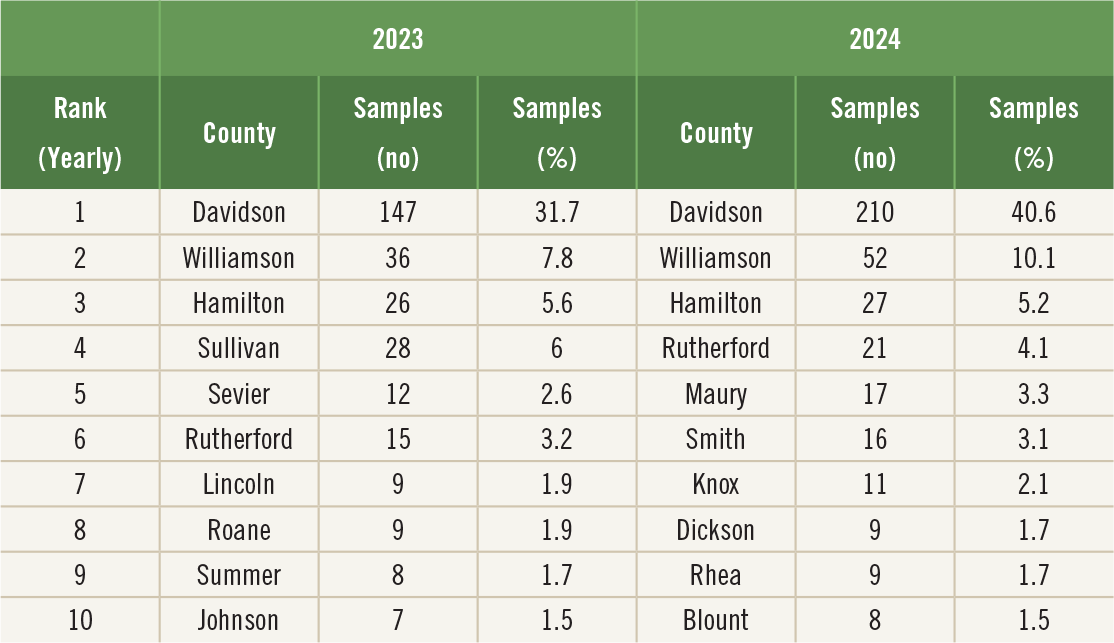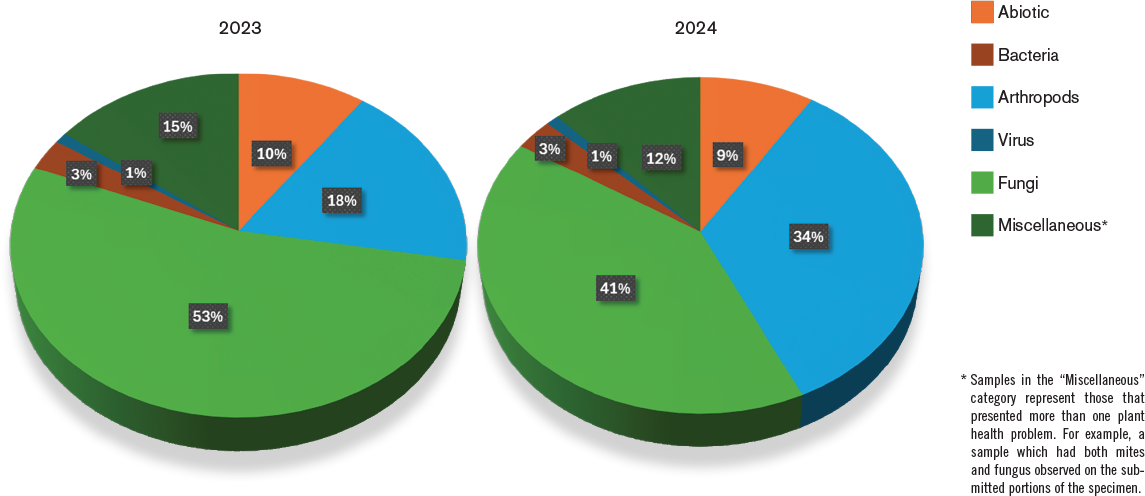
7 minute read
Feature
What Was Spied with Our (Microscopic) Eye: Updates on plant health problems diagnosed during peak months of 2023 and 2024
By Nar B. Ranabhat, Assistant Professor, Extension Plant Pathologist, Department of Entomology and Plant Pathology, University of Tennessee
Midhula Gireesh, Assistant Professor, Extension Entomologist, Department of Entomology and Plant Pathology, University of Tennessee
Sylvia Moraes, Plant Diagnostician, UT Soil, Plant and Pest Center, University of Tennessee
UT Plant Pest Diagnostic Lab provides timely diagnostics of plant pests, including pathogenic microorganisms, insects, mites, and nematodes that are found in association with submitted plant samples. The mission of the lab is to provide accurate pest identification to support UT research and Extension personnel, commercial growers, landscape companies, and homeowners. When preparing to submit a sample, having as much information as possible is critical for most accurate diagnosis. When you are submitting a sample or if someone brings samples to their county Extension office, having a checklist will help to ask questions or to fill out alongside the sample will help in diagnosing plant health problems. A sample of checklist questions to fill during sample submission is available online at: https://ornamentalpathologylab.tennessee.edu/useful-resources
This article summarizes plant health related samples submitted to the UT Plant Pest Diagnostic Lab from May to September in 2023 and 2024. Understanding the problems reported in our state and the prevalence of these challenges in recent years can help inform and prepare scouts, growers, and Extension agents to be on the lookout for problems in upcoming field seasons at the locations and in the crops and plants they monitor in nurseries, managed landscapes, and home gardens.
From May to September, the UT Soil, Plant and Pest Center received a total of 463 samples in 2023 and 517 samples in 2024 (Figure 1). In 2023, Extension agents were the top submitters, accounting for 38% of the total samples, followed by landscaper and homeowners. However, in 2024, landscaper submitted 27%, homeowner 25%, and Extension agents 23% (Figure 1). Our Extension agents are doing a fantastic job assisting all clientele in submitting the samples to the diagnostic lab.

In 2023, August was the peak month for sample submissions, with the lab receiving a total of 120 samples. In 2024 higher numbers were submitted from May to July, with the peak in May (145 samples) (Figure 2). Early scouting and identification are crucial for managing these problems effectively.

Samples were submitted from 69 different counties across Tennessee, with Davidson County submitting the most samples (147 in 2023 and 210 in 2024) (Table 1).

Boxwood samples were the most frequently submitted, followed by maple ( Acer spp.), arborvitae ( Thuja spp.), oak ( Quercus spp.), tomato ( Lycopersicon spp.), and cherry, peach or plum samples from species in the genus Prunus . ( Table 2 ). The prevalence of plant health problems often depends on favorable weather conditions for pathogens. In general, wet, humid, mild temperature favors disease development.

Most of the samples that were received by the lab in both 2023 (263 samples) and 2024 (294 samples) were woody ornamental landscape plant species (Figure 3). These samples most often were sent from the central and eastern regions of Tennessee. Other specimen host categories included small fruits, tree fruits, vegetables, tobacco and row crops (Figure 3). Row crop samples are primarily handled by the West Tennessee AgResearch and Education Center in Jackson, TN, where row crops are extensively grown.

Plant biotic problems, caused by disease-causing organisms including fungi, arthropods, bacteria, viruses, were the most common problems diagnosed in the lab during both years (Figure 4). Fungi were the most frequently identified pathogens occurring on submitted samples. An additional 10% of submitted problems were diagnosed as having abiotic causes, including issues attributed to nutritional deficiencies, and weather-related damage from frost damage, drought, or flooding. A “miscellaneous” category is included that refers to cases in which specimens were received in poor condition, inadequate sample collection (too little material, tissue from already dead host plant, or wrong plant tissues needed for diagnostics), or instances where improper shipping or delayed receipt negatively impacted sample condition. For guidance about how best to prepare and collect host plant samples and shipping instructions that yield best results, please visit UT Soil, Plant and Pest Center website:
https://soillab.tennessee.edu/plant-pests/plant-disease-diagnosis

General guidelines for horticulture pest management:
Early detection and accurate diagnosis are critical steps in efficient management of plant pests and diseases. For sustainable management, we always recommend integrated pest management (IPM). A single method of pest control may be effective initially, but it cannot manage pests in the long run. More importantly, once symptoms of a pest are evident, managing the pest can become costly, or even impossible or economically unfeasible. Therefore, some management practices can prevent pest problems from entering the production system. The following key precautions and management practices can reduce the likelihood of pest incidence and spread.
a) Exclusion: Exclusion means preventing any form of pest entering the production system. Follow all the procedures that exclude pests and start with a “clean” system. Order seeds, bulb, or tubers, seedling with a pathogen-free or phytosanitary certificate. Purchase pasteurized planting substrate and prevent contamination.
b) Avoidance: Avoidance is the strategy in which pest problems are avoided (or prevented) even when the causal organism is present. For example, avoid damaging plants and their parts, as damaged areas provide entry sites for disease causing organisms. Additionally, understanding what, when and where to plant is very important. For instance, a wrong plant in the wrong place and time can attract diseases, insects, and unwanted wildlife. So, make sure you invest time in proper plant selection and alter planting times to avoid peak pest pressure during the growing season.
c) Scouting and monitoring: Regular monitoring is a key step of integrated pest management, as early detection can prevent economic loss. Document key pests and all management practices that help to make pest management decisions.
d) Cultural practices: Many cultural practices can be adopted that support the goal of limiting plant stressors that can increase host susceptibility to pests and plant diseases. For example, use proper sanitation practices to reduce unintentional spread of plant pathogens from diseased to healthy plants. Eliminate plant pathogen and pest reservoirs by discarding or destroying diseased or infested plants/plant parts and fallen leaves away from healthy plants. Disinfect hands and pruning tools between plants, crops, or production areas, as appropriate. Use drip irrigation that reduces the time that leaves and stems remain wet. Or, if overhead irrigation is the only available option, schedule irrigation for the morning. Remove weeds promptly before they compete with crops. Do not allow weeds to produce viable seeds. Follow crop and plant fertilization guidelines and adhere to labeled rates.
e) Resistance: Use pest resistant or tolerant cultivars if available.
f) Plant management and protection: Apply appropriate physical, mechanical, biological and chemical control measures to cure plants that are already infected. Preventive chemicals are available to protect the plants from pest incidence.






